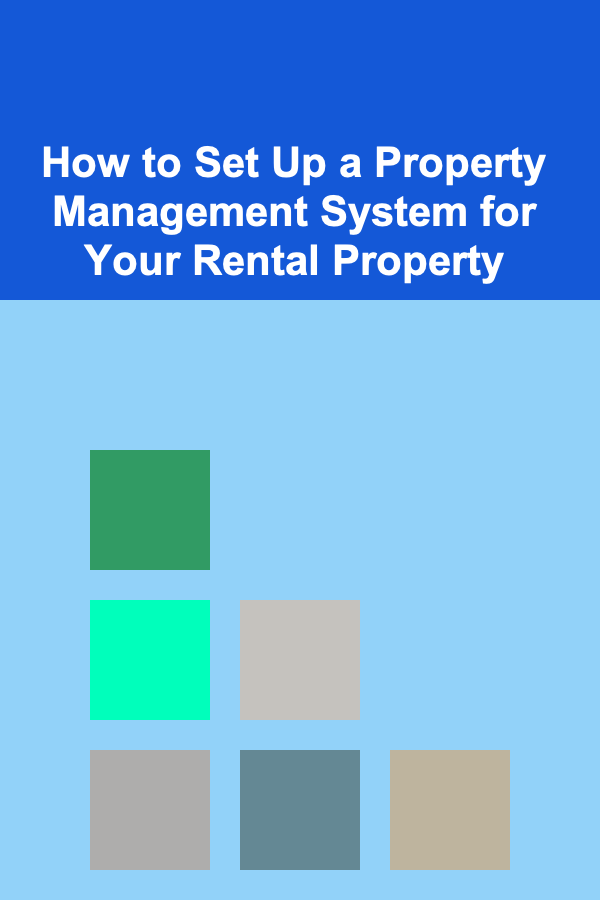
How to Set Up a Property Management System for Your Rental Property
ebook include PDF & Audio bundle (Micro Guide)
$12.99$6.99
Limited Time Offer! Order within the next:

Managing rental properties effectively is crucial for any landlord or property manager looking to maximize rental income while ensuring smooth day-to-day operations. A well-organized property management system (PMS) can streamline your processes, reduce administrative burdens, and enhance the tenant experience. In this article, we will explore how to set up a property management system that works for you, covering everything from basic setup to advanced automation features. Whether you're managing one rental property or a large portfolio, understanding how to structure a property management system will ensure that you remain efficient, organized, and proactive in addressing tenant needs.
Understanding the Basics of Property Management
Before delving into how to set up a property management system, it's essential to understand what a property management system is and why it is necessary for landlords and property managers.
A property management system is a suite of tools and technologies that streamline and automate the various tasks related to managing rental properties. These systems typically encompass a range of features that assist with tenant and lease tracking, rent collection, maintenance management, accounting, and communication. Depending on the size of your rental portfolio and the complexity of your operations, a PMS can help you manage all aspects of your business from a centralized dashboard.
At its core, the goal of a property management system is to increase efficiency, minimize errors, and provide a better experience for both tenants and property owners.
Step 1: Identify Your Needs and Goals
Before selecting a property management system or implementing one, you need to understand what your specific needs are. Property management systems come in a variety of shapes and sizes, and you should choose one that meets your unique requirements.
1.1 Assess Your Current Workflow
Take a close look at how you are currently managing your properties. Are you handling everything manually, using spreadsheets, or relying on several different software tools? Ask yourself:
- How are you currently keeping track of leases, tenants, and rental payments?
- Are you managing maintenance requests and repairs efficiently?
- How do you handle accounting and financial reporting?
- How do you keep in touch with tenants? Do you have an automated communication system?
- What challenges are you facing in terms of time management, compliance, and tenant satisfaction?
By identifying these pain points and areas for improvement, you can ensure that the property management system you set up will address your needs effectively.
1.2 Define Your Goals
Consider what you want to achieve by setting up a property management system. Your goals could include:
- Streamlining the rent collection process
- Reducing tenant turnover through improved communication
- Simplifying accounting and tax preparation
- Automating maintenance requests and repairs
- Improving marketing and tenant acquisition
By clarifying your goals, you will have a clear vision of what you want your property management system to achieve, allowing you to select the right features and tools.
Step 2: Choose the Right Property Management Software
Once you have a solid understanding of your needs and goals, the next step is to choose the right property management software. With a wide array of available software platforms, it is essential to select one that suits your specific needs.
2.1 Key Features to Look for
When choosing property management software, here are the key features that you should consider:
- Tenant and Lease Tracking: You need to be able to store tenant information, track lease dates, and monitor the status of your leases. This feature helps you stay on top of renewal dates, tenant contact information, and important lease clauses.
- Online Rent Collection: Online rent payments are convenient for both landlords and tenants. The software should allow tenants to pay their rent through various online methods (credit/debit cards, ACH transfers, etc.), which will save time and reduce the risk of late payments.
- Accounting and Financial Reporting: Look for software that offers comprehensive accounting features such as tracking income and expenses, generating reports, and helping with tax preparation. A good PMS should integrate with accounting systems to make financial management seamless.
- Maintenance Management: A PMS should offer a maintenance request system that allows tenants to report issues and track their resolution. Automated reminders for repairs, inspections, and preventive maintenance are also helpful.
- Tenant Communication: A built-in communication system allows landlords to send automated reminders, notices, and updates. It can also provide a centralized location for all tenant communication, reducing the need for phone calls and emails.
- Document Management: Organize leases, contracts, notices, and other important documents in one central location for easy access.
- Marketing and Vacancy Management: A PMS should help you advertise your property, screen tenants, and track inquiries. Features like vacancy alerts, tenant application forms, and online rental listings can help reduce vacancy time.
- Mobile App: Many property management systems offer mobile apps for landlords and tenants. This feature can be helpful for on-the-go property management and communication.
2.2 Evaluate Your Budget
Property management software comes with varying pricing models, including monthly subscriptions, annual fees, and pay-per-unit pricing. You should choose a software that fits within your budget while still offering the features you need. Compare multiple platforms and try out free trials to see which system offers the best value.
Some popular property management software options include:
- AppFolio
- Buildium
- TenantCloud
- Rentec Direct
- Propertyware
- Yardi Voyager
Step 3: Set Up Your Property Management System
Once you've selected your property management software, it's time to set it up. The setup process can vary depending on the software you choose, but here are general steps to follow:
3.1 Enter Property and Tenant Information
Start by entering basic information about your properties, such as:
- Property name
- Address
- Unit types and number of units
- Lease terms (start and end dates, rent amounts, security deposit information)
Next, add tenant details, including:
- Tenant names and contact information
- Lease start and end dates
- Rent payment terms and amounts
- Payment history
3.2 Customize Your System for Your Workflow
Many property management systems allow you to customize workflows, reminders, and automated tasks. Take advantage of these features by tailoring the system to your specific property management needs. Set up automated rent reminders, maintenance alerts, and lease renewal notifications to ensure that you stay on top of key dates and tasks.
3.3 Integrate with Other Tools
If you use other tools for accounting, email marketing, or communication, look for a property management system that can integrate with these platforms. This will help you centralize all your operations in one system, reducing the need for manual data entry and minimizing the risk of errors.
3.4 Set Up Payment Systems
Configure online payment options for tenants. Ensure that the rent collection system is set up for automatic invoicing, late fee calculation, and reminders. This can save you time by automating rent collection and making the process seamless for tenants.
3.5 Configure Reporting Features
Set up financial and maintenance reports in the software, ensuring that you can generate monthly, quarterly, and annual reports with ease. This will allow you to track your financial performance and identify any areas that need attention.
Step 4: Implement Efficient Tenant Management
Effective tenant management is a core aspect of a property management system. The following steps will help you manage your tenants in a streamlined and organized way:
4.1 Implement Tenant Screening
A property management system can integrate with tenant screening services to help you evaluate potential tenants. By conducting background checks, credit checks, and rental history verifications, you can reduce the risk of problematic tenants and ensure that you're renting to responsible individuals.
4.2 Facilitate Lease Renewals
Use your property management system to track lease expiration dates and send automated renewal reminders to tenants. Offer digital lease signing to make the process quicker and more efficient.
4.3 Handle Maintenance Requests
Allow tenants to submit maintenance requests directly through the property management system. Ensure that all requests are tracked and resolved in a timely manner. The system should allow you to assign tasks to maintenance staff, monitor progress, and keep tenants informed of the status of their requests.
4.4 Communicate Effectively
Set up automated messaging for routine communications, such as reminders for rent payments or maintenance appointments. Ensure that you're also able to quickly respond to tenant inquiries via the communication platform integrated into your system.
Step 5: Monitor and Optimize Your Property Management System
Once your property management system is set up and running, it's important to monitor its performance and optimize its usage over time.
5.1 Regularly Review Reports
Review the financial, tenant, and maintenance reports generated by your system to identify any areas of concern or potential improvements. For example, if you notice a high rate of late rent payments, consider adjusting your rent collection process or implementing additional late fees.
5.2 Seek Tenant Feedback
Periodically request feedback from your tenants to understand their experience with the property management system. This will help you identify any issues with communication, maintenance response times, or other aspects that could be improved.
5.3 Stay Updated with Software Features
Most property management software platforms release regular updates and new features. Stay informed about these updates to ensure you're taking full advantage of the capabilities of your system. New automation tools, reporting features, or integration options may improve your workflow and tenant satisfaction.
Conclusion
Setting up a property management system for your rental properties is a significant step toward streamlining your operations, improving tenant satisfaction, and increasing profitability. By assessing your needs, selecting the right software, and configuring the system effectively, you can enhance your property management efforts and run a more efficient business. Whether you're managing one property or a portfolio of properties, a well-implemented property management system can save you time, reduce costs, and lead to a more successful rental business.
Reading More From Our Other Websites
- [Hiking with Kids Tip 101] Family-Friendly Desert Routes: Where to Go, What to See, and How to Prepare
- [Home Storage Solution 101] How to Optimize Home Storage Solutions for Clothes
- [Personal Finance Management 101] How to Use the Debt Avalanche Method When You Have Irregular Income
- [Organization Tip 101] How to Develop a Routine for Virtual Workspace Maintenance
- [Skydiving Tip 101] From Takeoff to Landing: A Step‑by‑Step Guide to Editing a Skydiving Video
- [Organization Tip 101] How to Optimize Your Cloud Storage for Cost Efficiency
- [Home Space Saving 101] How to Unlock Vertical Space with DIY Pegboard Organization Ideas for Garages and Workshops
- [Home Staging 101] How to Enhance Curb Appeal for a Winning First Impression
- [Home Security 101] How to Improve Home Security for Renters: Tips and Solutions
- [Organization Tip 101] How to Foster Collaboration in Shared Volunteer Spaces

How to Care for and Maintain Your Home's Wooden Fences
Read More
How to Create a Kid-Friendly Bathroom Cabinet
Read More
How to Maintain and Care for Your Home's Deck or Patio
Read More
How to Use Lighting to Create a Cozy Reading Nook
Read MoreHow to Automate Your Legal and Accounting Expense Tracking
Read More
10 Tips for a Self-Care To-Do List Focused on Emotional Healing
Read MoreOther Products

How to Care for and Maintain Your Home's Wooden Fences
Read More
How to Create a Kid-Friendly Bathroom Cabinet
Read More
How to Maintain and Care for Your Home's Deck or Patio
Read More
How to Use Lighting to Create a Cozy Reading Nook
Read MoreHow to Automate Your Legal and Accounting Expense Tracking
Read More